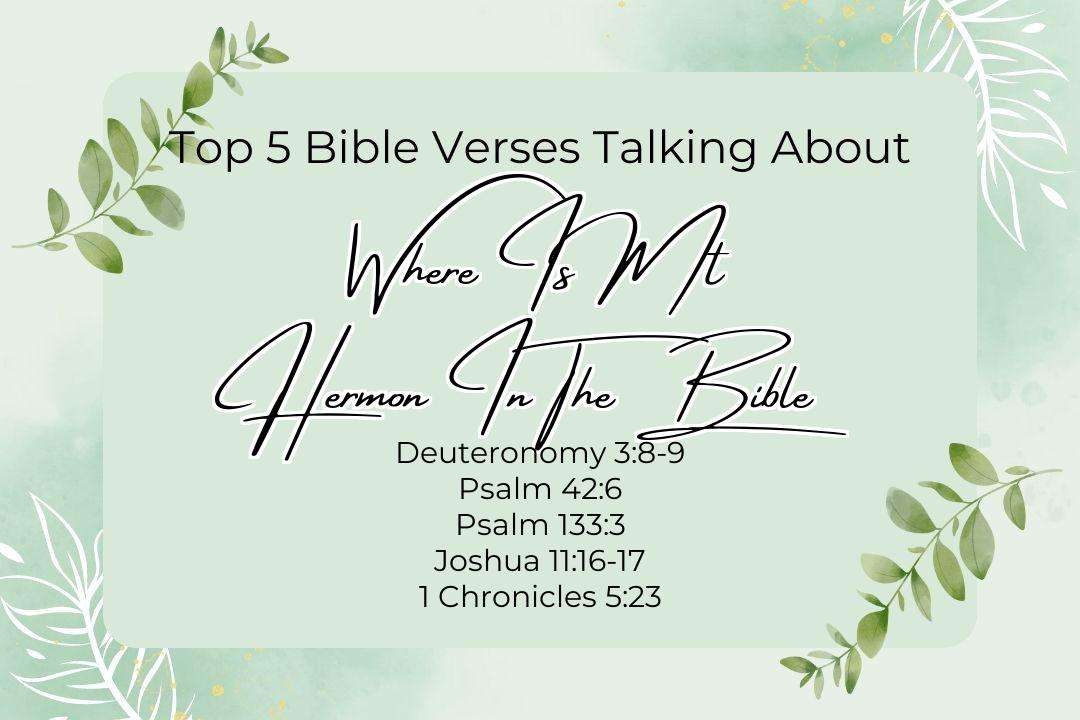I still get goosebumps thinking back to the time I stood at the northern tip of Israel – literally, where three countries converge, the air’s sharpness hitting me like a slap in the face, pine and snow and all that. Mt Hermon’s got some serious street cred, biblically speaking – it’s a mountain that’s been around the block a few times. Thing is, pinning down its exact role in the Bible, understanding why it matters in the grand tale of God’s people, that’s the real tricky part, and my mind’s still reeling from it all, to be honest.
Top 5 Bible Verses About Where Is Mt Hermon In The Bible
Personally, I find these scriptures super helpful in wrapping my head around the whole idea. Here’s a pic that, for me anyway, kinda brings it all into focus.
(to display the image, it would be best to see the actual suggestions made. Please go ahead and post the rest)

Picture by BibleBreathe.com about Where Is Mt Hermon In The Bible
Geographical Location of Mt Hermon in the Bible
Location of Mt Hermon in the Middle East
I recall the day I stumbled upon Mt Hermon in some Bible study like it was yesterday – had no clue what it was or why it’s even important, but there’s this nagging voice that I gotta dig deeper. And, so I’m pouring over maps, checking out biblical accounts, and whatnot, just to wrap my head around where it’s located. Anyway, turns out Mt Hermon’s situated in the Anti-Lebanon mountain range – that’s over in the Middle East. It’s like the highest point in that range, measuring 9,232 feet (2,814 meters) above sea level.
The views from up top gotta be pretty wild – all green, with valleys and whatnot down below. Made sense to me that a mountain as ruggedly beautiful as this has had such a huge impact on the whole region’s geography and history and all.
Borders of the Promised Land and Mt Hermon
Mt Hermon’s mentioned in Deuteronomy 3:8-9 – marks the northeastern edge of the Promised Land, according to the Bible. That mountain was pretty key to setting the lines between all the different territories way back then.
As I think about why Mt Hermon’s location is important, there’s this one bible verse I remember –
“Every place that the sole of your foot shall tread upon, that have I given unto you, as I said unto Moses.” (Joshua 1:3, KJV).
This bit always gets me thinking how God’s all about keeping his promises and watching over us as we figure out what’s what.
Significance of Mt Hermon’s Geographical Location
So what if Mt Hermon is here rather than somewhere else – why does any of it even matter? Its location’s significance goes deeper than just geographical coordinates – we’re talking the crossing point between heaven and earth. Mt Hermon stands for that awesome place that reminds us of how much bigger God is than us.
This verse in Psalms kind of nails why places like Mt Hermon hold so much weight –
“O Lord, I have loved the habitation of thy house, and the place where thine honour dwelleth.” (Psalm 26:8, KJV).
It’s like, these aren’t just places you walk by every day, they’re doors that open up to the divine – so that’s pretty deep, man. Reflecting on where Mt Hermon falls into everything in the Bible always blows my mind – I mean, the enormity of our creator is kind of cool.
Biblical References to Mt Hermon
I’m gonna be honest with you, there’s been times when I felt like I was stuck in a rut, like God was a million miles away. But I’ve found that turning to the Bible always gives me a bit of a boost, you know? That’s how I stumbled upon Mt Hermon – it’s this really cool mountain that gets mentioned a bunch of times.
A Symbol of Spiritual Longing
Psalm 42:6 says,
“O God, my soul is cast down within me: therefore will I remember thee from the land of Jordan, and of the Hermonites, from the hill Mizar” (Psalm 42:6, KJV).
So, like, Mt Hermon is this reminder that we all yearn for something greater, right? It’s like our souls are tryin’ to reach new heights, just like the mountain’s all snow-capped and whatnot.
A Picture of Unity and Blessing
Then there’s Psalm 133:3, which says,
“As the dew of Hermon, and as the dew that descended upon the mountains of Zion: for there the Lord commanded the blessing, even life for evermore” (Psalm 133:3, KJV).
Here, Mt Hermon’s dew is like this crazy refreshing thing that brings everyone together – kinda like a nice spring morning, but instead of just feeling nice, it’s God’s presence, which is way more powerful, obviously. And just like the dew helps the plants grow and all that, God’s presence makes our lives richer, you feel me?
A Landmark of God’s Faithfulness
I was reading through the Old Testament and I noticed that Mt Hermon keeps poppin’ up as this symbol of God’s faithfulness to His people. Like, in Deuteronomy 3:8-9 and 4:47-49, Joshua 11:16-17, 12:1, and 13:11, and 1 Chronicles 5:23, it’s always there, reminding the Israelites of God’s promises.
When I think about all these passages, it hits me how important it is to keep lookin’ at God’s faithfulness, just like the Israelites looked up at Mt Hermon and knew He was there. Hopefully, we can find some comfort in Mt Hermon’s majesty, and maybe even get a bit of a spiritual lift from knowin’ God’s always around.
My Journey Through Mt Hermon’s History

Photo modified by BibleBreathe.com. Original photo by Kiwihug on Unsplash
I still remember the day I first looked into Mt Hermon’s biblical account. What stuck with me was its incredible past and how much it means to people spiritually.
Digging into Mt Hermon’s Pagan Past
There’s this mountain range in Lebanon where Mt Hermon is, which people have considered super important for thousands of years. They used to do all sorts of pagan stuff there – Syrians, and other nations from around the area, would go all the way up to the top to make sacrifices to their gods. The snow up there made it seem even more special.
The Bible puts it this way,
“They provoked him to jealousy with strange gods, with abominations provoked they him to anger.” (Deuteronomy 32:16, KJV).
It’s kinda scary how quickly we – the people of God, I mean – turn our backs on him and look to fake idols for answers. Mt Hermon’s where a lot of that stuff went down.
How Mt Hermon Fit into the Plan to Conquer Canaan
From what I can tell, Mt Hermon also played a huge role when the Israelites were trying to conquer Canaan. Strategically speaking, its location was super important – made all the difference in the war. When the Israelites were finally able to capture the mountain, that was a major win for them.
Thinking back on all this makes me think about something Joshua said – he kept pushing the Israelites to be brave in the face of basically anything that tried to take them down.
The Bible puts it this way,
“Be strong and of a good courage; be not afraid, neither be thou dismayed: for the Lord thy God is with thee whithersoever thou goest.” (Joshua 1:9, KJV).
What Mt Hermon Really Represents in the Bible
Mt Hermon keeps popping up throughout the Bible, but its symbolism pretty much stays the same: spiritual power. Like, Jesus took Peter, James, and John there to pray, and then…he just transformed right in front of them.
It’s all gotten me thinking about this C.S. Lewis quote – “You don’t have a soul. You are a Soul. You have a body.” For some reason, that’s always made me think of Mt Hermon. To me, it feels like it’s the one spot on earth where things like heaven, and all that’s spiritual are super close by – feels almost palpable.
So I’ve been thinking – if Mt Hermon’s got that kind of spiritual heft, what if I start placing a little more emphasis on finding my own spiritual footholds in life? Could be actual places I go, or maybe it’s getting more serious about praying. The possibilities are endless. What matters most to me at the end of the day is being willing to take that first step into the unknown – positioning myself, you know? Then maybe – just maybe – I can get a glimpse of God’s transfiguring power like those apostles experienced with Jesus on that mountain.
Spiritual Significance of Mt Hermon
Mt Hermon as a symbol of spiritual refreshment
Thinking back, my spiritual journey’s been kinda like that one relative you don’t really know what to make of – some days we’re good, some days we’re a total mess. And Mt Hermon, I guess you could say that’s my go-to place to chill when things get outta hand.
So I did some research, Mt Hermon’s actually located in the Golan Heights, right on the border of Israel, Lebanon, and Syria. Don’t get it twisted, the fact it’s over 9,000 feet up in the air ain’t the reason I care – there’s way more to this place.
The Bible says,
“They that dwell under his shadow shall return; they shall revive as the corn, and grow as the vine: the scent thereof shall be as the wine of Lebanon.” (Hosea 14:7, KJV).
For some reason, whenever I think about Mt Hermon, I think about taking time to focus on my faith, away from all the craziness life throws at us.
The connection between Mt Hermon and the Transfiguration of Jesus
Mt Hermon’s special place in history goes beyond that though – apparently, Jesus’ Transfiguration went down there, so they say. At that moment, He revealed His true nature as the Son of God, the one He’d been sent to do.
Here’s how the Bible describes the whole scene:
“And it came to pass about an eight days after these sayings, he took Peter and John and James, and went up into a mountain to pray. And as he prayed, the fashion of his countenance was altered, and his raiment was white and glistering.” (Luke 9:28-29, KJV).
For me at least, it’s like that one instant flipped a switch, opened my eyes up wide to who he truly is.
The role of Mt Hermon in biblical prophecy
Mt Hermon ends up being pretty key to other stuff too – just flick to Psalm 42 and you can see this; someone hankering to give their thanks to God up on the mountain.
The psalm reads:
“O my God, my soul is cast down within me: therefore will I remember thee from the land of Jordan, and of the Hermonites, from the hill Mizar.” (Psalm 42:6, KJV).
Mt Hermon has a certain pull to it, and if I’m honest it just makes me wonder if it really could be an echo, whispering about the real spiritual home we’re heading towards.
Archaeological Discoveries on Mt Hermon
I’ve been kinda intrigued by the whole biblical significance thing about Mt Hermon. The more I read, the more it seems these archaeological discoveries have changed the game when it comes to understanding this place. We see Mt Hermon pop up a few times in the Bible, including in Psalm 133:3, which says,
“As the dew of Hermon, and as the dew that descended upon the mountains of Zion: for there the Lord commanded the blessing, even life for evermore” (Psalm 133:3, KJV).
It feels like this verse pretty much sums up how majestic and beautiful this mountain is. And all the cool stuff archaeologists have found there just adds to that.
Ancient Temples and Ruins on Mt Hermon
When folks started digging around on Mt Hermon, they uncovered some ancient temples and ruins that go back to Roman and Greek times. I guess what’s coolest about these findings is getting a peek into what people back then believed and how they lived their lives. Paul wrote something in the Bible that keeps popping into my head –
“The invisible things of him from the creation of the world are clearly seen, being understood by the things that are made” (Romans 1:20, KJV).
You can’t help but be impressed by how clever and skilled our ancestors were. And those old temples and ruins seem to say something deeper about humans: we’ve always been trying to connect with something bigger than ourselves.
Inscriptions and Artifacts Found on Mt Hermon
The stuff that’s been uncovered on Mt Hermon has also included all sorts of inscriptions and artifacts. Those have been super helpful for researchers who are trying to piece together what life was like back then. There’s this one inscription from around the 2nd century BC that’s especially significant. It tells us about how people worshipped on Mt Hermon way back when.
The Significance of Archaeological Discoveries on Mt Hermon
So what do all these archaeological finds really mean? For me, at least, they show how faith and worship can leave a lasting impact. Like it says in the Bible,
“The mountains shall bring peace to the people, and the little hills, by righteousness” (Psalm 72:3, KJV).
Discovering all this stuff on Mt Hermon pretty much proves that faith isn’t just something we each do alone; it’s also about community and tradition and what we get from our ancestors.
Mt Hermon in Modern Times
Current geographical and environmental issues on Mt Hermon
Reflecting on Mt Hermon, its beauty kinda takes your breath away – but even a place this stunning has its modern-day problems. I mean, the thing is, Mt Hermon is smack bang on the border of Lebanon and Syria, and it stretches into northern Israel, so it’s gotta be affected by stuff going on around it, right? The Bible says,
“And it came to pass, when the children of Israel heard of it, that they were afraid of the people, and believed not in the Lord: and the Lord said unto Moses, Fear him not: for I have delivered him into thy hand, and all his people, and his land; and thou shalt do to him as thou didst unto Sihon king of the Amorites, which dwelt at Heshbon. So they smote him, and his sons, and all his people, until there was none left him alive: and they possessed his land, from Arnon unto Hermon.” (Numbers 21:33-34, Numbers 34:7-8 and Deuteronomy 3:8, and Josh 11:16-17 and 13:5,11 and Psalms 42:6-7, KJV).
Nowadays, there’s some major concerns about the environment; people are cutting down trees, polluting, and basically using up all the natural resources, which ain’t good for anyone.
The gorgeous, snowy peaks of Mt Hermon are seriously suffering because of climate change – the temperatures keep going up, so the snow melts super early now, which disrupts all the ecosystems and stuff.
Tourism and exploration on Mt Hermon
But despite all the problems, people are still real keen to check out Mt Hermon. It’s like this ultimate adventure destination: you can go skiing, check out ancient ruins, or just take in the views.
For me, exploring Mt Hermon has been like this life-changing experience. I mean, you can just hike through the forests, visit old ruins, or look out at the views, and you can’t help but feel how special this place is.
The ongoing significance of Mt Hermon in biblical studies and archaeology
Now, I know archaeologists and scholars are still all about studying Mt Hermon – and they’re always learning new stuff about the ancient civilizations that used to be here. According to Psalms, “Deep calleth unto deep at the noise of thy waterspouts: all thy waves and thy billows are gone over me. Yet the Lord will command his lovingkindness in the day time, and in the night his song shall be with me, and my prayer unto the God of my life. I will say unto God my rock, Why hast thou forgotten me? why go I mourning because of the oppression of the enemy?” (Psalms 42:7-9, KJV). Hermon’s like this symbol of deep devotion.
Thing is, Mt Hermon’s still got a ton of secrets that could shed some light on where our faith even came from. It’s more than just some spot on the map; it’s this active piece of history.
Mt Hermon’s as captivating now as it’s ever been, drawing in all these seekers of truth and wisdom and adventure with its majestic peaks.
What Do You Think?
How does this passage resonate with you? Drop a comment and let’s discuss it together!
Share this with your network and see what other interesting reads we have at BibleBreathe.com!

Photo modified by BibleBreathe.com. Original photo on Unsplash.
Frequently Asked Questions About Where Is Mt Hermon In The Bible
What is the biblical significance of Mount Hermon?
To be honest, I find Mount Hermon pretty fascinating – it’s said to be the place where Jesus underwent this radical transformation, showing off His divine side to Peter, James, and John, which is a pretty big deal if you ask me.
Where is Mount Hermon located in relation to Israel?
So Mount Hermon’s all the way up north, right by the border of Lebanon and Syria – that’s where you’ll find it on the map, and yep, it’s a major player in the Bible.
What does the Bible say about the Transfiguration of Jesus on Mount Hermon?
Now, the Bible does say Jesus had this Transfiguration thing go down on a mountain, but here’s the thing, it doesn’t actually specify Mount Hermon – most folks think it was probably Mount Tabor, but still, it’s a wild moment where Jesus lets His divine flag fly, giving Peter, James, and John a little peek at who He really is.
Matt Turner
I’m Matt, and I love breaking down Bible verses in a way that’s easy to understand and apply to everyday life. My goal is to help you connect with God’s Word and find practical ways to live it out. Whether you’re new to the Bible or just looking for some fresh insights, I’m here to walk with you and share what I’ve learned along the way.

